The St. Albert Botanic Park has one of the largest collections of hardy shrub roses in Alberta. In addition to these shrubs, volunteers have planted and are successfully growing a variety of tender roses (hybrid teas, floribundas, grandifloras). We are sharing information on our planting methods, care and feeding during the growing season and winter protection so everyone can grow and enjoy these beautiful plants.
Rose Selection
There are many different types of roses. St. Albert is located in Climactic Zone 3 and roses such as Hybrid Teas, Grandifloras, Floribundas, Miniatures and English Roses are all “tender” roses and need good winter protection in order to survive. With experience you learn that many of these tender roses are quite winter hardy and survive for years, while some are very tender and weaken as the years go by, even with good winter protection.
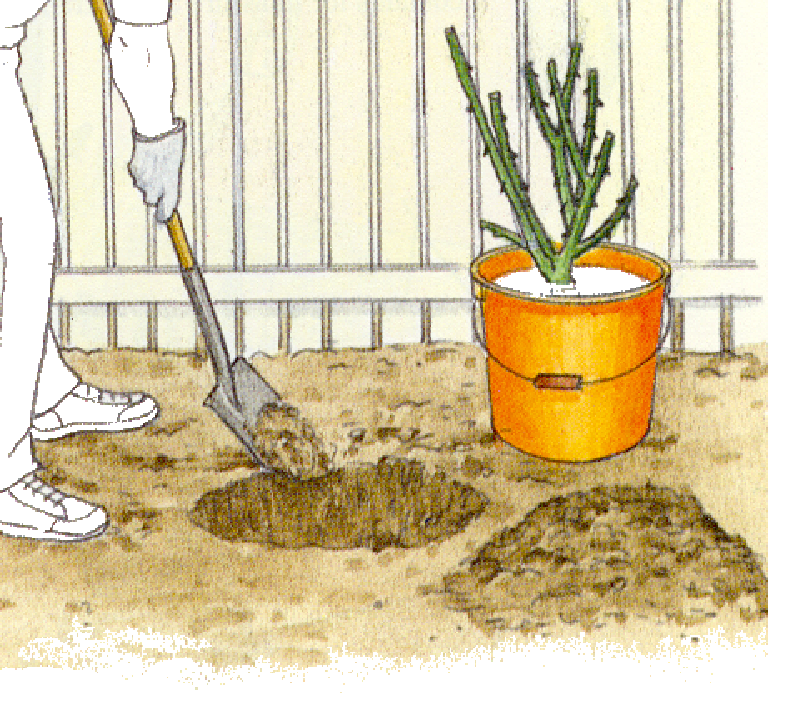 Shrub roses also vary in their hardiness, but generally tend to be more resilient to our cold winters. The hardiness zone is usually provided when purchasing shrubs and we can decide whether or not to stay with Zone 2 or 3 hybrids or take a chance on Zones 4 to 6. Some old fashioned rose groups such as the Bourbons, Damasks and Musks are only hardy to Zone 5, but they may be grown here if treated like a tender rose and given winter protection. However, their canes may suffer winter damage and severe pruning each spring will never allow them to reach the heights and glory normally found in roses grown in milder climates.
Shrub roses also vary in their hardiness, but generally tend to be more resilient to our cold winters. The hardiness zone is usually provided when purchasing shrubs and we can decide whether or not to stay with Zone 2 or 3 hybrids or take a chance on Zones 4 to 6. Some old fashioned rose groups such as the Bourbons, Damasks and Musks are only hardy to Zone 5, but they may be grown here if treated like a tender rose and given winter protection. However, their canes may suffer winter damage and severe pruning each spring will never allow them to reach the heights and glory normally found in roses grown in milder climates.
It is preferable to plant either bare root or container grown roses as these plants will have a complete root system. Roses which have had their roots chopped off to fit in a box on the store shelf will take much longer to get established and may not be a strong enough plant to carry over through the winter. The grade of a rose should also be considered. A grade 1 rose will have at least 3 strong canes. Grades 1 ½ or 2 have fewer and smaller canes.
Site Selection
Roses require a good garden loam which is neither too alkaline or too acidic. They need a well drained location away from the roots of large trees which would continually use moisture and nourishment intended for your roses. Do not plant roses in areas where water tends to accumulate as they do not like to have “wet feet”. Roses love sun – the more they have, the stronger their canes will be. A minimum of 6 hours is necessary, more if possible and strong afternoon sun is the best. However, this may depend on the plant but if you have a plant with naturally thin or weak canes….look for a very sunny spot.
Site Preparation
Soil should be well worked to a minimum depth of 18″. Existing soil should be improved by adding generous amounts of well-rotted manure, compost and peat moss. Heavy clay soil can be made more productive with the addition of coarse sand, vermiculite or perlite. Very sandy soils can be improved by incorporating some clay and organic matter. Work bonemeal into the soil at the rate of 1 cup per plant. If possible, soil should be allowed to settle for a couple of weeks before planting.
Recommended Spacing
Bush Roses such as Hybrid Teas should be planted from 18″ – 30″ apart, depending on the vigor of the variety. Shrub Roses can be planted from 3′ – 5′ apart. With shrubs, consider the growth habits of each shrub you plant as they come in many different sizes and types such as sprawling groundcovers or upright climbers.
Planting Your Rose
If you have ordered plants bare root, place the roots in a pail of water or a mixture of 2 tbsp 20-20-20 to 5 gallons of water for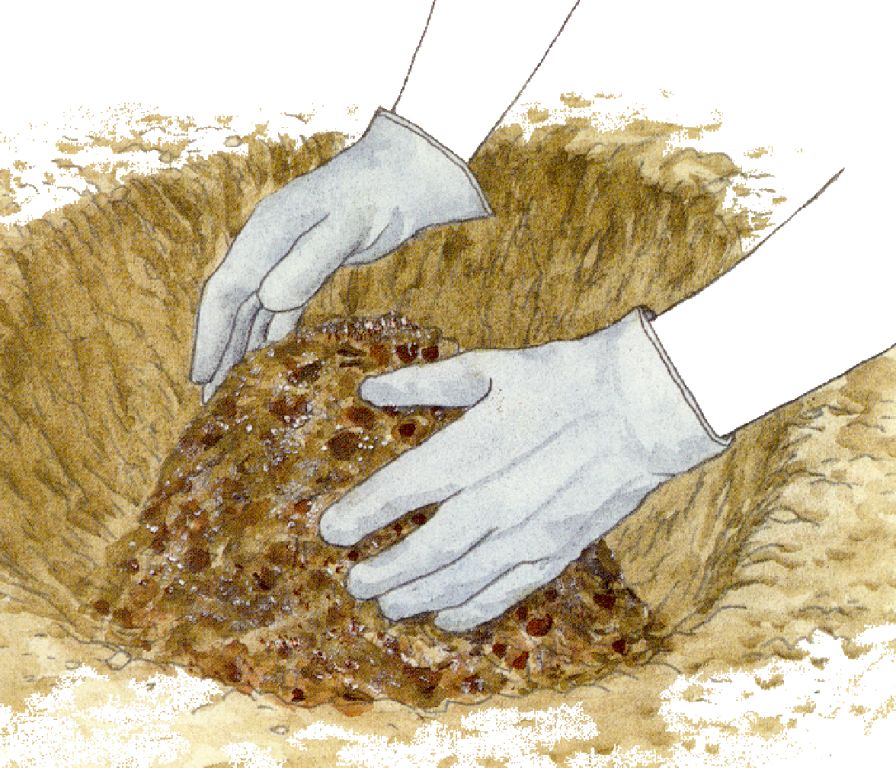 two days. After soaking, roses should be planted immediately. Dig a hole large enough to accommodate the root system of your rose. Set the plant on a small mound of soil placing roots carefully around the mound. Position the plant so that the graft union is 4″ – 6″ below the finished grade of the soil. Correct placement of the graft union is one of the most important points to remember in planting roses in our region. If the rose has a very long rootstock, it can be planted at a 45 degree angle keeping the graft union at 4″-6″ below the soil. Planting at an angle is beneficial for two reasons – it encourages more basal breaks and roots will be happier growing at a depth of 6″ – 12″ instead of lower down as they might be if their long rootstock was planted straight down. Once your rose is in proper position,
two days. After soaking, roses should be planted immediately. Dig a hole large enough to accommodate the root system of your rose. Set the plant on a small mound of soil placing roots carefully around the mound. Position the plant so that the graft union is 4″ – 6″ below the finished grade of the soil. Correct placement of the graft union is one of the most important points to remember in planting roses in our region. If the rose has a very long rootstock, it can be planted at a 45 degree angle keeping the graft union at 4″-6″ below the soil. Planting at an angle is beneficial for two reasons – it encourages more basal breaks and roots will be happier growing at a depth of 6″ – 12″ instead of lower down as they might be if their long rootstock was planted straight down. Once your rose is in proper position, 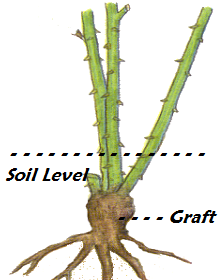 fill the planting hole with soil to about three-quarters full and firm the soil well around the roots. Fill the hole with water and allow it to drain. The moist soil will settle around the roots and you can finish by filling the planting hole with soil.
fill the planting hole with soil to about three-quarters full and firm the soil well around the roots. Fill the hole with water and allow it to drain. The moist soil will settle around the roots and you can finish by filling the planting hole with soil.
If your new rose is container grown it may be dealt with in one of two ways. If dormant (no shoots have started growing), remove from the pot and treat as a bare root plant. If your rose has started to grow, there will also be root growth below the soil. Try to minimize shock to the plant by removing carefully from the pot and placing very gently in planting hole. Finish planting as with bare root plants.
At the St. Albert Botanic Park, all roses are planted with careful consideration to the depth of the graft union whether they are tender hybrid teas or hardy rugosa shrubs. The graft (or bud) union is the point where a shoot of a rose has been grafted to a much hardier rose. Known as the rootstock, this lower hardier plant enables the entire plant to better survive freezing temperatures. Planting this union below the soil surface as described above is the first step in ensuring your rose survives our winters.
Care of Your Newly Planted Rose
The first few weeks after planting is a critical time for your new rose. With good growing conditions, it will take this long for your plant to recover from transplanting shock and to develop new roots. If your rose has been growing in a greenhouse, it will likely have an abundance of foliage and even buds or blooms. It may need to be conditioned or ‘hardened’ off by keeping it in a protected location outdoors until you feel that temperatures are above zero at night and foliage begins to feel firm. To lessen transplant ‘shock’, you would be wise to plant on a cooler or cloudy day, try not to disturb any root growth and water..water..water. If one of these conditions is not met, your foliage may droop for a few days until it recovers. Buds that droop may or may not recover but open blossoms will likely not.
Hardening off is not necessary for bare root plants whose new shoots have not yet appeared. They can be planted as indicated in our Planting directions. To protect against sun scald and drying winds, soil can be mounded around the lower canes until buds begin to break. At all times, ensure that your plant is well watered. Do not fertilize until new growth is 3-6″ long.
New rose growers may not realize how much water a rose really requires. They are a woody shrub with the potential to produce many blossoms several times during a growing season. To give you their best performance, a rose must be watered well and fertilized on a regular basis.
Maintenance
Of all the little chores that go along with growing beautiful roses, the most important is watering. Roses require about 5  gallons of water per plant per week or 1″ of rain. Do not water in the hot sun and be sure foliage is dry by nightfall. Routine cultivation around your roses not only controls weeds but loosens the soil surface which opens it up for better moisture penetration.
gallons of water per plant per week or 1″ of rain. Do not water in the hot sun and be sure foliage is dry by nightfall. Routine cultivation around your roses not only controls weeds but loosens the soil surface which opens it up for better moisture penetration.
A regular fertilizing program closely follows watering in importance if you want to be rewarded with wonderful displays of blossoms. Roses are heavy feeders and need a consistent supply of nutrients. Apply a generous amount of compost or manure about the first of May. Every two weeks follow with a liquid fertilizer mixed ½ strength. Use any suitable “rose food” fertilizer, e.g. 6-12-8. In the spring, add 1 tbsp of micronized iron per 1 gallon of fertilizer solution. This is helpful in prevention of roses become anemic or chlorotic (rose leaves will appear yellow with dark green veins). Heavy rains and use of alkaline city water tends to deplete magnesium in the soil. To counteract this add 2 tsp of Epsom salts per plant per year. The last feeding of fertilizer should be no later than August 15th; 10-30-20 or 10-52-10 can be used to help harden off plants for winter.
Deadheading of spent flowers is necessary to ensure a continuous supply of bloom and help prevent disease. Cut just above an outward facing 5-leaflet leaf on a cane strong enough to support a new bloom.
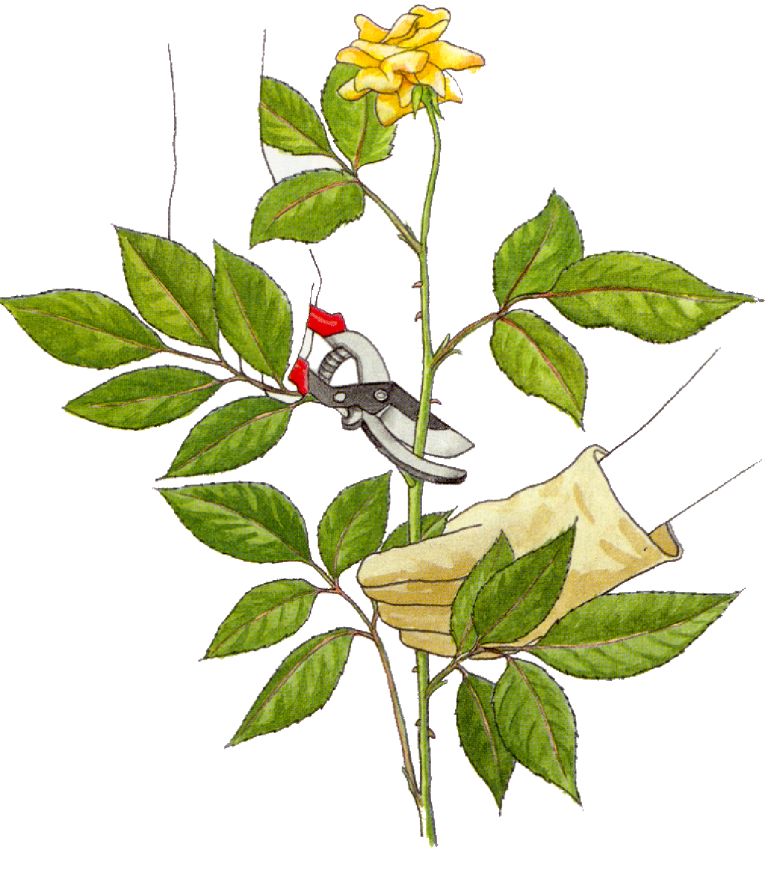
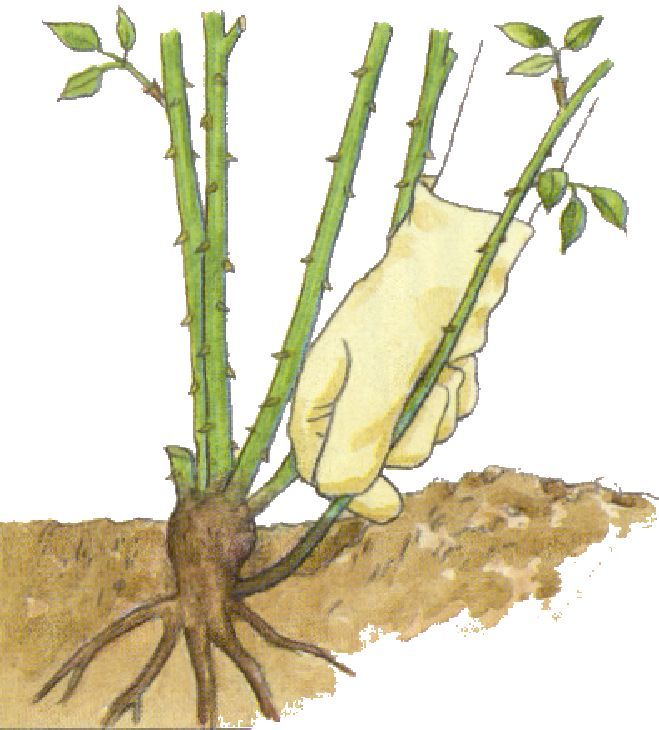 All grafted roses which include hybrid teas, floribundas, grandifloras and many of the shrubs will occasionally have shoots grow out from below the graft or bud union. These shoots should be removed at their base as soon as you spot them. These shoots are actually canes growing from the hardier rose to which your ‘tender’ rose is grafted on. If left to grow, the rootstock rose may eventually overtake the tender plant and prevent it from thriving. They are usually easy to spot as they a) grow very quickly, b) have 7 leaves instead of 5 and c) can have a dark red cane with dangerous looking thorns.
All grafted roses which include hybrid teas, floribundas, grandifloras and many of the shrubs will occasionally have shoots grow out from below the graft or bud union. These shoots should be removed at their base as soon as you spot them. These shoots are actually canes growing from the hardier rose to which your ‘tender’ rose is grafted on. If left to grow, the rootstock rose may eventually overtake the tender plant and prevent it from thriving. They are usually easy to spot as they a) grow very quickly, b) have 7 leaves instead of 5 and c) can have a dark red cane with dangerous looking thorns.
Roses need regular treatment with protective sprays for disease control. A fungicidal spray such as Funginex can be used regularly for Blackspot and Mildew. A solution of 2 tbsp baking soda to 1 gallon of water sprayed weekly has also shown to be fairly effective. Spraying regularly with Wilt-Pruf has shown to decrease the occurrence of mildew. At the Botanic Park we tend to have good open air movement in our Rose Garden and have been able to avoid any diseases except an occasional bout of mildew.
Pests are infrequent visitors to roses, but should be treated with a method (or chemical) of your choice as the need arises. At the Botanic Park, we have had several serious outbreaks of aphids. We allow nature to take its course and our local lady bug quickly multiplies and her offspring take care of the aphids for us naturally.
Mulching
Our greatest resource and secret weapon in the early years of the St. Albert Botanic Park, particularly in the Rose Garden, was our mulch. We used a very coarsely chipped wood mulch that was provided by the City of St. Albert’s mulching program.
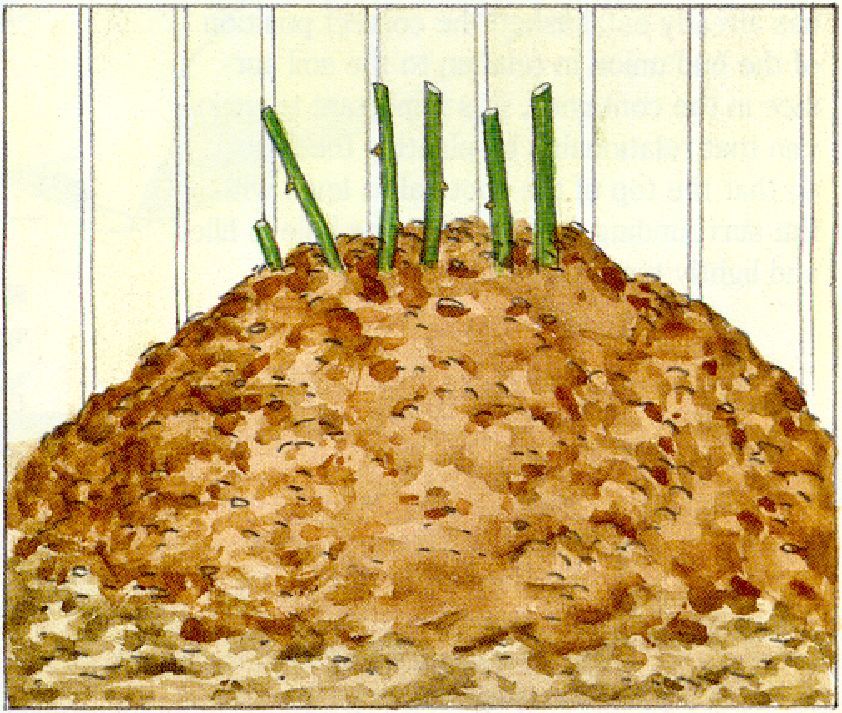 The mulch kept weeds somewhat under control throughout the Park, but its greatest benefit was in the protection it provided in the Rose Garden. During the growing season the mulch conserves moisture and keeps the ground wet until nature brings more rain. In the winter, it provides a little extra insurance to the already buried graft unions on the shrub roses. The hybrid teas were heavily mulched sometimes as deep as 12″. Due to rising prices and the large quantity of mulch we required, the Park volunteers began to experiment with other methods of winter protection for the more tender of our roses. An inexpensive alternative to wood mulch was found right under our feet. The endless supply of leaves that fall at the end of each gardening season became our new ‘mulch’. As the days get shorter and colder, volunteers trim down the tender roses just enough so that they fit under cardboard boxes. Each box is packed with dry leaves which will provide insulation through the winter. Be sure to seal the top of the box so the leaves do not blow away.
The mulch kept weeds somewhat under control throughout the Park, but its greatest benefit was in the protection it provided in the Rose Garden. During the growing season the mulch conserves moisture and keeps the ground wet until nature brings more rain. In the winter, it provides a little extra insurance to the already buried graft unions on the shrub roses. The hybrid teas were heavily mulched sometimes as deep as 12″. Due to rising prices and the large quantity of mulch we required, the Park volunteers began to experiment with other methods of winter protection for the more tender of our roses. An inexpensive alternative to wood mulch was found right under our feet. The endless supply of leaves that fall at the end of each gardening season became our new ‘mulch’. As the days get shorter and colder, volunteers trim down the tender roses just enough so that they fit under cardboard boxes. Each box is packed with dry leaves which will provide insulation through the winter. Be sure to seal the top of the box so the leaves do not blow away.
Pruning
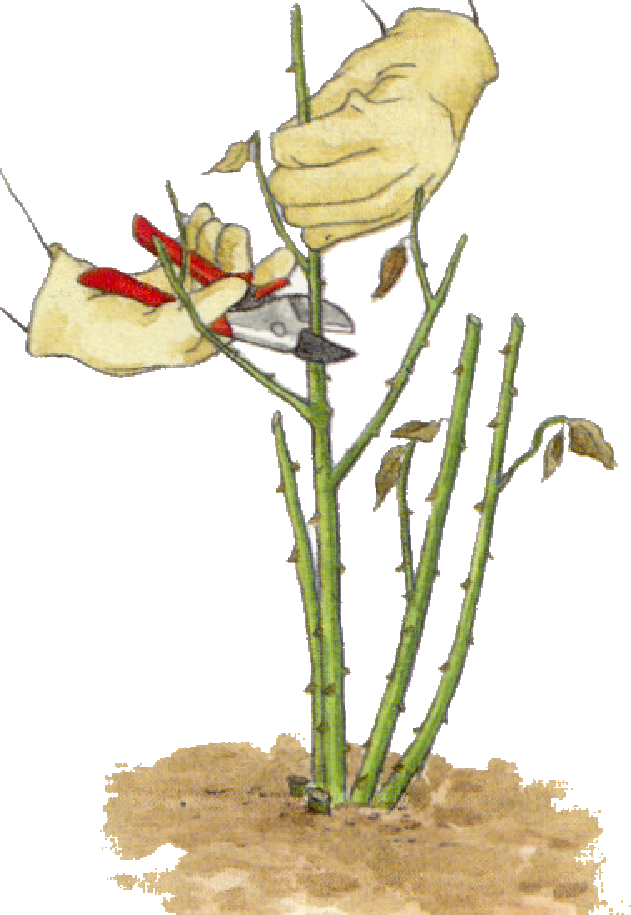
 In our extremely cold winters, very few tender rose canes survive above their winter protection. In the spring, any dead or diseased wood should be cut back to green wood. Cuts should be made at an angle 1/4″ above an outward facing bud. The same rules apply for shrub roses, except that older unproductive canes need to be removed on occasion to make room for new more vigorous canes. Modern shrub roses which bloom on new wood should be pruned each spring, selecting 3-5 of the strongest canes and removing the rest.
In our extremely cold winters, very few tender rose canes survive above their winter protection. In the spring, any dead or diseased wood should be cut back to green wood. Cuts should be made at an angle 1/4″ above an outward facing bud. The same rules apply for shrub roses, except that older unproductive canes need to be removed on occasion to make room for new more vigorous canes. Modern shrub roses which bloom on new wood should be pruned each spring, selecting 3-5 of the strongest canes and removing the rest.
Pruning can be very intimidating for a new gardener. There is that fear that cutting away too much of the plant may harm it but in the case of roses, a hard pruning is exactly what they need. You will be rewarded with a strong plant with sturdy canes and lots of beautiful blossoms. Keep in mind that removing spent flowers is also a form of pruning – be sure to remove enough of the stem so that the new flower that forms will be on a stem strong enough to support it.
Miniature Roses
Just a brief note on these beautiful little plants. They require the same care and requirements as the larger roses. Planting though is relatively easy as they are not grafted, but grown on their own roots from cuttings. They should be planted 2″ deeper than they were in their original containers. Miniature roses need very little pruning. Just prune them to the desired shape. Cut any new shoots which have emerged from below the soil line to about 1/2 its length. When the branches finish flowering, cut them back to a new outward facing bud. It can take a hybrid tea rose up to 6 weeks or more to form a new bud and have it open. Miniatures have much smaller buds so a new flower can form very quickly and they are rarely out of bloom making them a perfect plant in the landscape.
Growing Roses in Containers
For gardeners with limited space or those whose rose collections are growing faster than their planting beds, growing roses in containers is a viable option. Hybrid Teas are particularly showy in containers set on patios where we can enjoy their beauty and fragrance at close range.
Pots should be 5 gallon size or larger; miniatures can be grown in a 1 gallon pot or larger. Plant in a light soil mix with peat moss for water retention and sufficient perlite to allow drainage. It is important that the pot has good drainage holes on the bottom. Roses must be kept well watered and not be allowed to dry out.
In the fall, roses must be buried in their pots or removed from the pots and laid in a trench dug in your garden. Cover with 1-2 feet of soil. In the spring, gently remove roses from their winter home and pot up once again. An alternative to burying your roses is to keep them in their containers and find them a winter home in a cold storage room (root cellar) or a garage with a temperature of just above freezing. They should be kept in the dark and watered on occasion.
Tree Roses
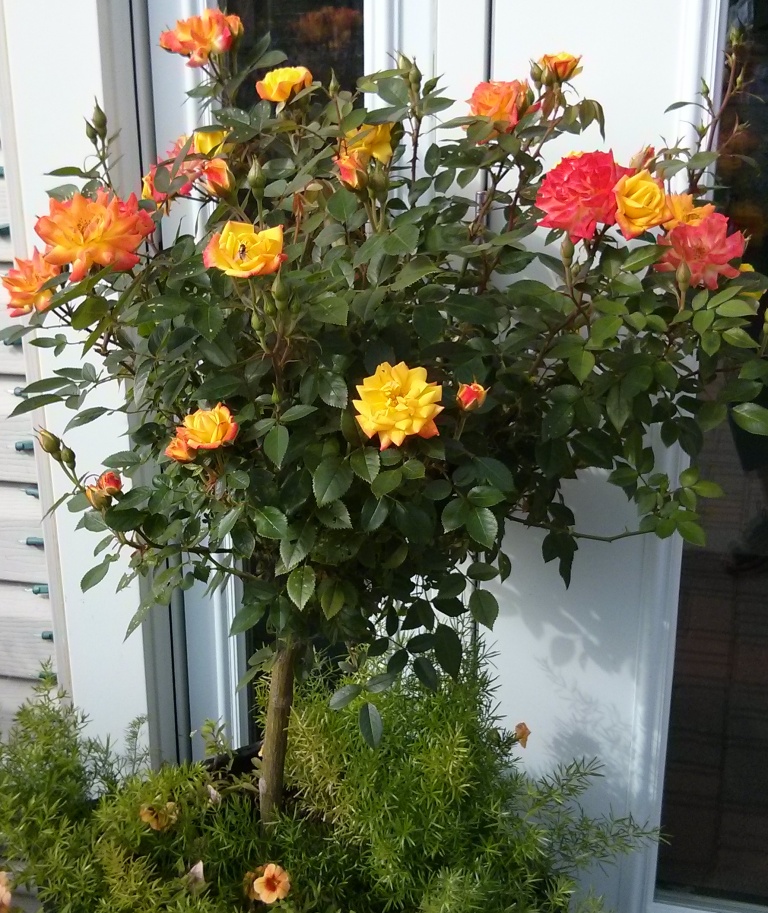 Tree roses are plants that have a tall central stem or ‘trunk’ that has a rose (usually tender) grafted on the top. These stems can be 1.5′ – 3′ tall with another 1′ – 3′ of growth at the top depending on the size of the grafted rose.
Tree roses are plants that have a tall central stem or ‘trunk’ that has a rose (usually tender) grafted on the top. These stems can be 1.5′ – 3′ tall with another 1′ – 3′ of growth at the top depending on the size of the grafted rose.
With everything from the graft up not hardy to our Zone 3, this area needs special winter protection. The tree rose needs to be laid flat in a trench or on the ground in the garden and buried with soil, peat moss or another insulating material. Plants can also be stored in a cold storage room or in a garage as noted above for container grown plants. As there may be one or more roses grafted on to the ‘tree’, it is a good idea to keep the area around the grafts from drying out. Wrapping damp sphagnum moss around the grafted areas will keep the plant viable. Mist occasionally with water.
The tree rose on the left is a miniature. It has a ‘trunk’ of 18″ with the popular miniature rose ‘Rainbow’s End’ grafted on the top which doubles the height of the entire plant.